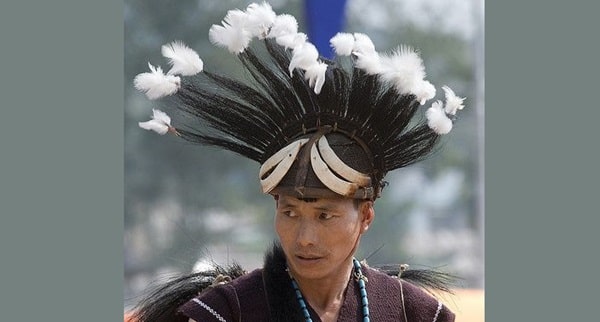The diversity of Arunachal Pradesh is very much prevalent in the cultural weavings. Not only that the people here are respectful to the culture they grow in, but also that they wish to use the symbols of these cultural and traditional intricacies in their daily lives. This is why, if you visit Arunachal, you will find men and women wearing the traditional dresses there most often. The dresses, standing as the symbols of their ethnic identity and beliefs, offer you the unknown stories of the region. Also, you will find out too, that the dresses for men and the dresses for women have distinctive features. Here are the details that we share with you regarding the same.
Arunachal Pradesh Traditional Dress for Men:
Arunachal Pradesh men’s traditional dress is functional and cultural. Their elaborate headgear and vibrant undergarment represent the region’s many tribes.
1. Gale (Headgear):

Arunachali men’s hats, the Gale, represent culture and identity. Bamboo, cane, or regionally sourced textiles make the Gale more than clothing—it represents history. The Gale’s intricate patterns reflect the wearer’s style and deeper meanings concerning tribal affiliations, societal institutions, and religion. The Gale’s curvature and rich decoration represent the wearer’s culture and position. Gale’s design highlights Arunachal Pradesh’s unique diversity. The Gale’s size, style, and ornaments represent state tribal customs.
2. Tingmai (Upper Garment):
Tingmais, Arunachal Pradesh men’s top garments, convey culture and identity. The sleeveless jacket combines function and cultural symbolism. Tingmais, handwoven fabric or animal skins, show the region’s craftsmanship and love of nature. Beyond aesthetics, its design and decoration are culturally important. The Arunachali people’s deep connection to nature is seen in the Tingmai’s intricate animal, tribal, and environmental designs. Arunachal’s painters’ expertise and beautiful beading, shells, and threads make the Tingmai stand out. Each embellishment enhances an important component of Arunachali men’s traditional attire.
3. Baku (Lower Garment):
The Baku, or Galey, symbolizes Arunachal Pradesh men’s traditional clothing’s cultural history and utility. Handwoven cotton or wool underwear blends heritage and utility. Its skirt-like wraparound design makes it flexible and comfortable on the region’s difficult terrain. Baku’s cotton belt conforms to the waist and adjusts. Beyond its fundamental utility, the Baku is a cultural and self-expression canvas. Arunachali color palettes and patterns reflect tribal and personal tastes. Beyond clothes, the Baku symbolizes toughness and flexibility. Its continued use in Arunachali men’s attire shows tradition-modern ties.
Arunachal Pradesh Traditional Dress for Women:
Traditional Arunachal Pradesh women’s dress showcases indigenous craftsmanship and culture. Arunachal Pradesh ladies wear beautiful, complicated outfits. Their traditional clothing includes:
1. Kong (Headgear):
Women in Arunachal Pradesh wear the Kong to show off their culture like men. Bamboo, cane, or woven fiber Kongs are exquisite and creative Arunachali crafts. More than headwear, the Kong’s superb design and decoration express cultural pride and identity. Each Kong’s beads, feathers, and shells show their clan and flair. Different tribes’ Kong styles and ornamentation show Arunachal Pradesh’s cultural diversity. Kongs represent social status and community beyond their beauty. Arunachal Pradesh women proudly wear the Kong throughout festivals, festivities, and everyday life,blending heritage with modernity. The family heirloom Kong preserves Arunachal’s indigenous heritage.
2. Yameng (Upper Garment):
Women of Arunachal Pradesh love the Yameng as their top. Cotton or silk is handcrafted into this long, sleeveless tunic or shirt. It is clothes and a canvas for cultural and artistic expression. Its exquisite embellishments distinguish the Yameng. Local women artisans’ intricate stitching, mirror work, and exquisite lace designs are included in each Yameng. These embellishments enhance the clothing and highlight the region’s culture. Yameng colors and patterns reflect the surrounding nature, culture, and traditions. Flowers, animals, and geometric designs symbolize fertility, wealth, and cultural identity, while bright colors reflect vitality and abundance.
3. Pati (Lower Garment):
Arunachal Pradesh women wear the practical and culturally rich Pati. Handwoven Patis are wrap-around skirts or curtains with bright colors, intricate motifs, and tribal themes. The Pati, fastened around the waist with a cotton belt, lets women move freely in the region’s diverse settings. It’s suitable for everyday and special occasions. Tribal diversity and Arunachali culture’s complexity are shown by pati length and style. Ankle-length skirts are normal, however certain tribes prefer knee-length draperies to reflect their culture.
Conclusion
In a nutshell, it can be said that the traditional dresses of Arunachal Pradesh, of both men and women, exhibit the true identity of the region through the design and craftsmanship. They are the important parts of the cultural celebrations as well. Just like any other parts of India, these dresses carry the soul of the state, ad people living in it. A gallant reminder of the indigenous culture of the land, the dresses continue to amaze so many.

